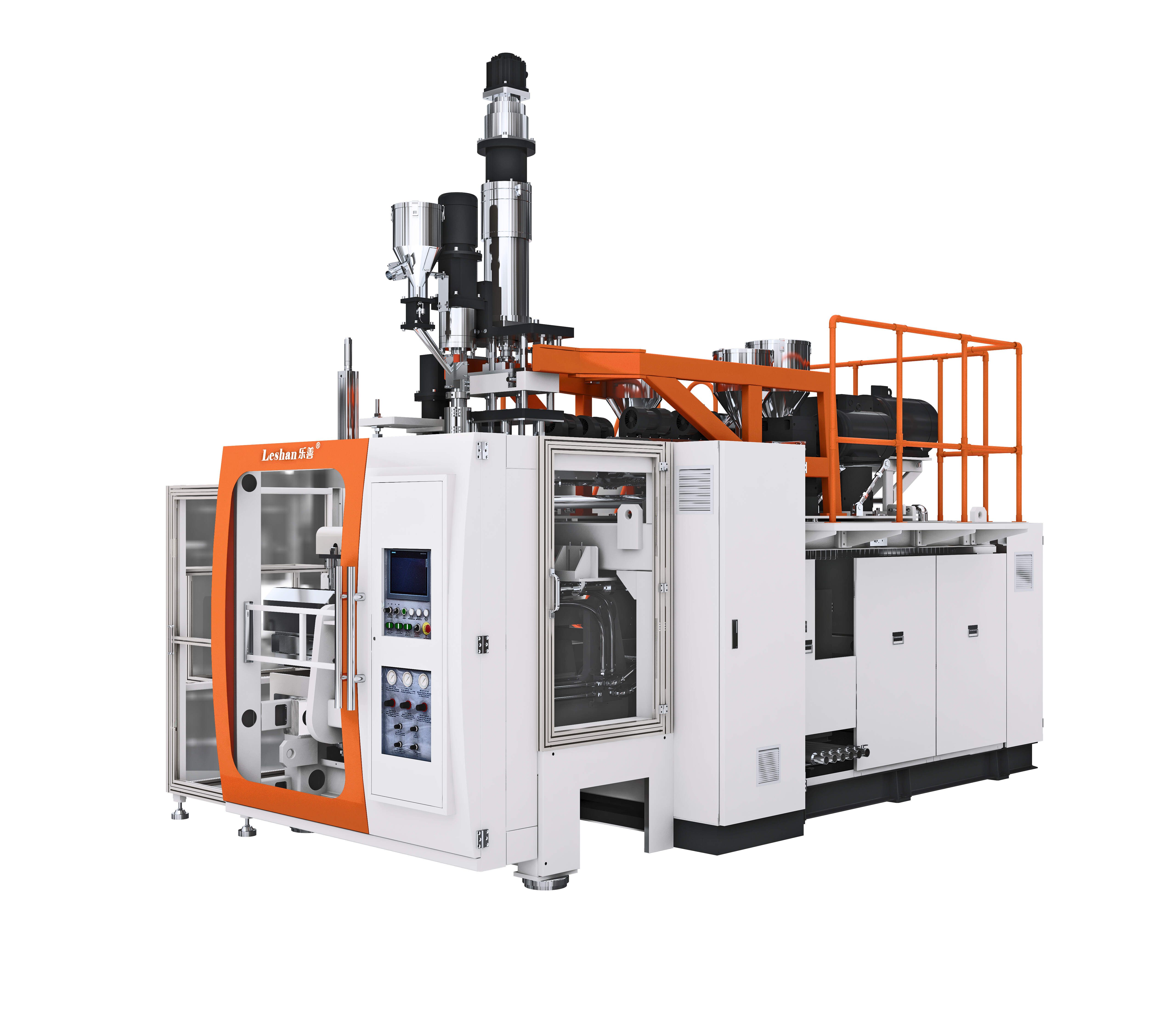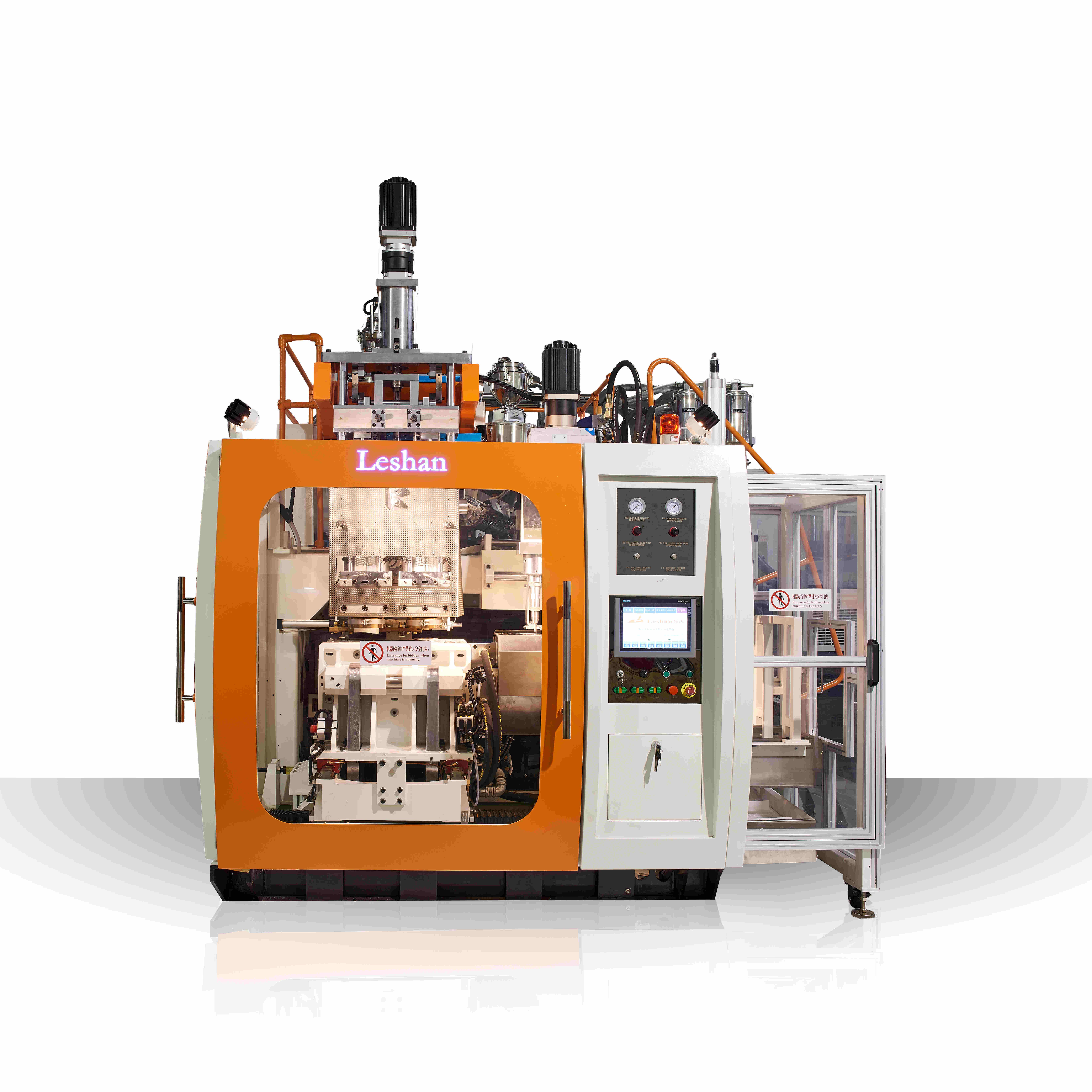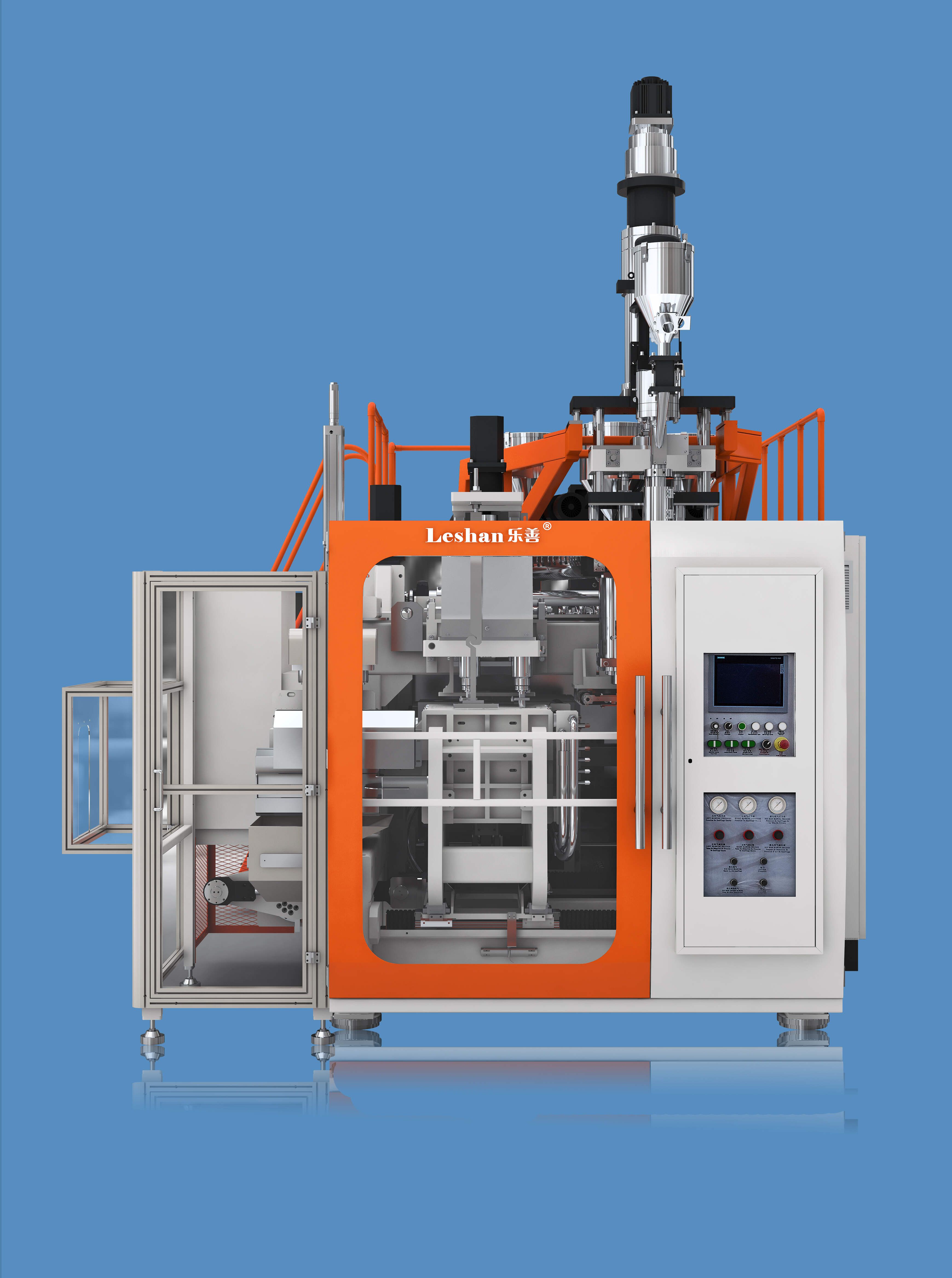
1l bottle blow molding machine
1l bottle blow molding machine
Leshan Intelligent Equipment Company is a well-known firm of expert China blow molding machine supplier that provides you with the finest solution when it comes to plastic production. With the guaranteed optimal production of plastic bottles, the top-tier China bottle blow molding machine manufacturer We introduce our customers to the latest machinery technology so that they can improve the productivity in their industries and provide high-quality products to their customers.
Our main products include Hydraulic Blow Molding Machine, All-Electric PET Blow Molding Machine,High-precision Mould,Chemical barrel blow molding machine,Daily chemistry bottle blow molding machine,Auxiliary machine,Irregular shape product blow molding machine,Blowing Mould & Injection Mould,multi-layer coextrusion blow molding machine,Extrusion Die Head,Engine oil bottle blow molding machine,Food bottle blow molding machine,Milk bottle blow molding machine,etc.Both various regions sales team and service network are dedicating to supply the impeccable pre-sales and after-sales service. We also offer the fastest reaction and solution to clients'questions and requirements.
| Parameter | Information |
|---|---|
| Product Name | 1l bottle blow molding machine |
| Brand Name | Leshan |
| Place of Origin | Foshan,Guangdong |
| Plastic Processed | PC,PVC,EVA,ABS,PP,PE...etc |
| Air Pressure(MPa) | 0.8 MPa |
| Color | Customized Color |
| Delivery Time | 45 days |
| Port | ShunDe/GuangZhou/ShenZhen China |
| Export region | Africa,America,Oceania |
| Export Country | Russia, Australia, Poland,Russia,Botswana,Togo...etc |
| Application | Bottle |
| OEM/ODM | Support |
| Core Components | Gear,Pressure vessel,PLC,Pump,Motor,Engine...etc |
| Voltage | 380V |
| Service | Field installation, commissioning and training... |
| MOQ | 1 set |
| Certification | ISO9001,CE... |
| Supply Ability | 500 Set/Sets per Month |
| Weight (T) | 5-18(According to specific model) |
| Packaging Details | Standard exporting machine packing with plastic film |
| Lead time (days) | 70 (To be negotiated) |
Please note: The above table data is for reference only. For specific information, please contact us.

As a commonly used plastic processing machine, 1l bottle blow molding machine has the characteristics of powerful functions and easy operation. It can complete the heating, plasticizing, blowing, cooling and other processes of plastic in one mold feeding and molding process, thereby making the product lightweight, durable, transparent and other advantages.
At the same time, the blow molding machine also has high production efficiency, can continuously produce large quantities of products, and is suitable for manufacturing plastic containers of various specifications and shapes.

1l bottle blow molding machine---FAQs Guide
2.What is the noise level of the 1l bottle blow molding machine?
3.Why does the blow molding machine make so much noise when it exhausts?
4.How does the extrusion blow molding process differ from injection blow molding, and what types of products are typically produced using each method?
5.How long does it usually take to troubleshoot 1l bottle blow molding machine?
6.What are the steps for cleaning and maintaining a 1l bottle blow molding machine?
7.What are the main components of a 1l bottle blow molding machine?
8.What is the operating cost of a 1l bottle blow molding machine?
9.What is the working principle of a blow molding machine?
10.Can you supply the on-site installation,commissioning,training service for 1l bottle blow molding machine?
11.How to choose the mold head of a 1l bottle blow molding machine?
12.What is the cost composition of 1l bottle blow molding machine?
1.What products are typically manufactured using 1l bottle blow molding machine?
Our products & services cover a wide range of areas and meet the needs of different fields.
1. Plastic bottles and containers: Blow molding machines are commonly used to produce plastic bottles and containers of various sizes and shapes, such as water bottles, shampoo bottles, and food containers.
2. Automotive components: Many automotive parts, such as fuel tanks, air ducts, and bumpers, are manufactured using blow molding machines.
3. Toys: Blow molding machines are used to produce a wide range of plastic toys, including balls, action figures, and building blocks.
4. Household products: Items such as laundry baskets, storage bins, and trash cans are often made using blow molding machines.
5. Medical equipment: Many medical devices, such as IV bags, syringes, and respiratory masks, are manufactured using blow molding machines.
6. Packaging materials: Blow molding machines are used to produce packaging materials such as plastic bags, pouches, and containers for food and other consumer products.
7. Industrial and agricultural products: Large containers, drums, and tanks used in industrial and agricultural settings are often made using blow molding machines.
8. Sports equipment: Blow molding machines are used to produce a variety of sports equipment, including footballs, soccer balls, and hockey sticks.
9. Furniture: Some types of furniture, such as chairs and tables, are made using blow molding machines to create lightweight and durable plastic components.
10. Construction materials: Blow molding machines are used to produce pipes, tubes, and other construction materials made from plastic.
2.What is the noise level of the 1l bottle blow molding machine?
1l bottle blow molding machine is not a product only, but also can help you comes to money-making.
The noise level of a blow molding machine can vary depending on the specific machine and its operating conditions. However, on average, blow molding machines can produce noise levels between 80-100 decibels (dB). This is considered to be a high level of noise and can potentially cause hearing damage if proper precautions are not taken. It is important for operators and workers to wear appropriate hearing protection when working with blow molding machines.
3.Why does the blow molding machine make so much noise when it exhausts?
The exhaust valve is blocked or the exhaust valve and exhaust pipe are too small.
4.How does the extrusion blow molding process differ from injection blow molding, and what types of products are typically produced using each method?
We have been working hard to improve service quality and meet customer needs.
Extrusion blow molding and injection blow molding are two different processes used to manufacture plastic products. While both methods involve melting plastic and shaping it into a desired form, there are some key differences between the two.
Extrusion blow molding is a process in which a molten tube of plastic, called a parison, is extruded through a die and then inflated to form a hollow product. The parison is then cooled and the mold opens to release the finished product. This process is commonly used to produce bottles, containers, and other hollow objects.
On the other hand, injection blow molding involves injecting molten plastic into a mold cavity, where it is then cooled and solidified. The mold then opens to release the finished product. This process is commonly used to produce small, complex, and precise products such as medical devices, pharmaceutical packaging, and small bottles.
One of the main differences between the two processes is the way the plastic is shaped. In extrusion blow molding, the plastic is shaped by the inflation of the parison, while in injection blow molding, the plastic is shaped by the mold cavity.
Another difference is the type of molds used. In extrusion blow molding, the molds are typically made of two halves that come together to form the desired shape. In injection blow molding, the molds are usually made of a single piece that is opened and closed to release the product.
The type of plastic used also differs between the two processes. Extrusion blow molding is typically used for high-density polyethylene (HDPE) and polyethylene terephthalate (PET) plastics, while injection blow molding is commonly used for polypropylene (PP) and polyethylene (PE) plastics.
In terms of product applications, extrusion blow molding is commonly used for larger, more simple products such as bottles and containers, while injection blow molding is used for smaller, more complex products such as medical devices and pharmaceutical packaging.
In summary, extrusion blow molding and injection blow molding are two different processes used to manufacture plastic products. While both methods involve melting plastic and shaping it into a desired form, they differ in the way the plastic is shaped, the type of molds used, and the types of products produced.
5.How long does it usually take to troubleshoot 1l bottle blow molding machine?
Our mission is to provide customers with the best solutions for 1l bottle blow molding machine.
The time it takes to troubleshoot a blow molding machine can vary depending on the specific issue and the experience of the technician. In some cases, it may only take a few minutes to identify and fix the problem, while in more complex cases it may take several hours or even days to fully troubleshoot and resolve the issue. It is important to thoroughly diagnose and address any problems with the machine to ensure it is functioning properly and producing high-quality products.

6.What are the steps for cleaning and maintaining a 1l bottle blow molding machine?
We adhere to the principle of integrity and transparency, and establish long -term relationships with partners, and we attach great importance to this detail.
1. Shut off and unplug the machine: Before starting any cleaning or maintenance, make sure the machine is turned off and unplugged to avoid any accidents.
2. Remove excess material: Use a scraper or a brush to remove any excess material from the machine, including the mold, extruder, and die head.
3. Disassemble the machine: Depending on the type of blow molding machine, you may need to disassemble certain parts to access all the areas that need cleaning. Refer to the manufacturer's manual for specific instructions.
4. Clean the mold: Use a mild detergent and warm water to clean the mold. Make sure to remove any residue or buildup from the mold surface. You can also use a specialized mold cleaner for tougher stains.
5. Clean the extruder and die head: Use a brush or scraper to remove any residue or buildup from the extruder and die head. You can also use a specialized cleaner for these parts.
6. Check and clean the cooling system: The cooling system is essential for maintaining the temperature of the machine. Check for any clogs or buildup in the cooling channels and clean them with a brush or compressed air.
7. Lubricate moving parts: Use a lubricant recommended by the manufacturer to lubricate all the moving parts of the machine. This will help prevent wear and tear and ensure smooth operation.
8. Inspect and replace worn parts: Check all the parts of the machine for any signs of wear and tear. Replace any damaged or worn parts to ensure the machine's optimal performance.
9. Reassemble the machine: Once all the parts are cleaned and inspected, reassemble the machine following the manufacturer's instructions.
10. Test the machine: Before using the machine again, run a test cycle to ensure everything is working correctly.
11. Regular maintenance: To keep the machine in good working condition, it is essential to perform regular maintenance tasks such as cleaning, lubricating, and inspecting the machine. Refer to the manufacturer's manual for a recommended maintenance schedule.
7.What are the main components of a 1l bottle blow molding machine?
We have rich industry experience and professional knowledge, and have strong competitiveness in the market.
1. Extruder: This is the main component of a blow molding machine, which melts and forms the plastic material into a parison (hollow tube).
2. Die Head: The die head is responsible for shaping the parison into the desired shape and size.
3. Clamping Unit: The clamping unit holds the mold in place and provides the necessary pressure for the blowing process.
4. Blow Pin: The blow pin is used to inflate the parison and shape it against the mold.
5. Cooling System: The cooling system helps to cool down the plastic material and solidify it into the desired shape.
6. Control System: The control system is responsible for controlling and monitoring the various parameters of the blow molding process, such as temperature, pressure, and speed.
7. Mold: The mold is the cavity into which the plastic material is blown and takes the shape of the final product.
8. Ejector: The ejector removes the finished product from the mold after the blowing process is complete.
9. Hydraulic System: The hydraulic system provides the necessary power and pressure for the various movements of the machine.
10. Electrical System: The electrical system controls the various motors and sensors of the machine.
11. Air Compressor: The air compressor supplies the compressed air needed for the blowing process.
12. Chiller: The chiller is used to cool down the extruder and other components of the machine to maintain the required temperature.
13. Conveyor System: The conveyor system moves the finished products out of the machine for further processing or packaging.
8.What is the operating cost of a 1l bottle blow molding machine?
We attach importance to the innovation ability and team spirit of employees, have advanced R & D facilities and laboratories, and have a good quality management system.
The operating cost of a blow molding machine can vary depending on factors such as the size and type of machine, the materials being used, and the production volume. However, some common operating costs include:
1. Energy costs: Blow molding machines require a significant amount of energy to operate, including electricity for heating and cooling processes. The cost of energy can vary depending on the location and the efficiency of the machine.
2. Labor costs: The cost of labor includes the wages of operators and technicians who run the machine, as well as any maintenance or repair personnel.
3. Material costs: The cost of materials, such as plastic resins, can vary depending on the type and quality of the material being used.
4. Maintenance and repair costs: Regular maintenance and occasional repairs are necessary to keep the machine running smoothly, and these costs should be factored into the overall operating cost.
5. Overhead costs: This includes expenses such as rent, insurance, and administrative costs that are necessary for the operation of the machine.
Overall, the operating cost of a blow molding machine can range from a few hundred dollars per day for a small machine to thousands of dollars per day for a large, high-volume machine.
9.What is the working principle of a blow molding machine?
We focus on innovation and continuous improvement to maintain a competitive advantage.
The working principle of a blow molding machine involves the use of compressed air to inflate a molten plastic tube or parison inside a mold cavity. This creates a hollow shape that is then cooled and solidified to form a plastic product.
The process begins with the plastic material, usually in the form of pellets, being fed into a hopper and then melted in an extruder. The molten plastic is then forced into a long tube or parison, which is then clamped between two halves of a mold.
Next, a nozzle is inserted into the parison and compressed air is blown into it, causing the plastic to expand and take the shape of the mold cavity. The mold is cooled to solidify the plastic, and then the mold halves are separated, and the finished product is ejected.
The blow molding process can be either extrusion blow molding or injection blow molding, depending on the type of machine used. In extrusion blow molding, the parison is formed by extruding the molten plastic through a die, while in injection blow molding, the parison is formed by injecting the molten plastic into a mold cavity.
The working principle of a blow molding machine is based on the principles of thermodynamics and fluid mechanics, where the expansion of compressed air inside the parison creates pressure that forces the plastic to take the shape of the mold. This process allows for the production of hollow plastic products with complex shapes and sizes.
10.Can you supply the on-site installation,commissioning,training service for 1l bottle blow molding machine?
Yes. We can. But this service cost will be extra cost based on which location.

11.How to choose the mold head of a 1l bottle blow molding machine?
We pay attention to the introduction and training of talents, scientifically regulate the management system, and focus on cultural construction and team cohesion.
1. Determine the type of blow molding machine: The first step in choosing the mold head is to determine the type of blow molding machine you have. There are three main types of blow molding machines: extrusion blow molding, injection blow molding, and stretch blow molding. Each type requires a different type of mold head.
2. Consider the material: The material you will be using for your product is also an important factor in choosing the mold head. Different materials have different properties and require different mold heads. For example, if you are using a high-density polyethylene (HDPE) material, you will need a mold head with a larger opening to accommodate the material's higher melt flow rate.
3. Determine the shape and size of the product: The shape and size of the product you want to produce will also play a role in choosing the mold head. The mold head needs to be able to create the desired shape and size of the product. If you are producing a complex shape, you may need a mold head with multiple cavities or a custom-made mold head.
4. Consider the production volume: The production volume also needs to be taken into account when choosing the mold head. If you are producing a large volume of products, you may need a mold head with multiple cavities to increase production efficiency.
5. Check the compatibility with the machine: It is important to ensure that the mold head you choose is compatible with your blow molding machine. The mold head needs to fit securely and work seamlessly with the machine to produce high-quality products.
6. Look for quality and durability: The mold head is a crucial component of the blow molding process, and it is important to choose one that is of high quality and durable. Look for mold heads made from high-quality materials and with a good track record of performance.
7. Consider the cost: The cost of the mold head is also an important factor to consider. While it is important to choose a high-quality and durable mold head, it is also important to stay within your budget. Compare prices from different suppliers and choose one that offers a good balance of quality and cost.
8. Consult with experts: If you are unsure about which mold head to choose, it is always a good idea to consult with experts in the field. They can provide valuable insights and recommendations based on your specific needs and requirements.
12.What is the cost composition of 1l bottle blow molding machine?
We focus on providing high 1l bottle blow molding machine quality products and services.
The cost composition of blow molding machines can vary depending on the type and size of the machine, as well as the manufacturer and country of origin. However, the general cost composition can be broken down into the following components:
1. Machine base: This includes the main frame, base plate, and other structural components of the machine. It typically accounts for 20-30% of the total cost.
2. Extruder: The extruder is the heart of the blow molding machine and is responsible for melting and shaping the plastic material. It can account for 30-40% of the total cost.
3. Molds: Molds are used to shape the plastic material into the desired product. The cost of molds can vary greatly depending on the complexity and size of the product being produced. It can account for 20-30% of the total cost.
4. Control system: The control system includes the electrical and electronic components that control the operation of the machine. It can account for 10-15% of the total cost.
5. Hydraulic system: The hydraulic system is responsible for providing the necessary pressure and power to operate the machine. It can account for 5-10% of the total cost.
6. Other components: Other components such as motors, pumps, valves, and sensors can also contribute to the overall cost of the machine.
In addition to these components, the cost of blow molding machines may also include expenses such as labor, transportation, and installation. It is important to note that the cost composition may vary depending on the specific features and capabilities of the machine.
Tags: cincinnati milacron blow molding machines,pe tank blow molding machine,davis standard blow molding machines,pesticide bottle blow moulding machine
